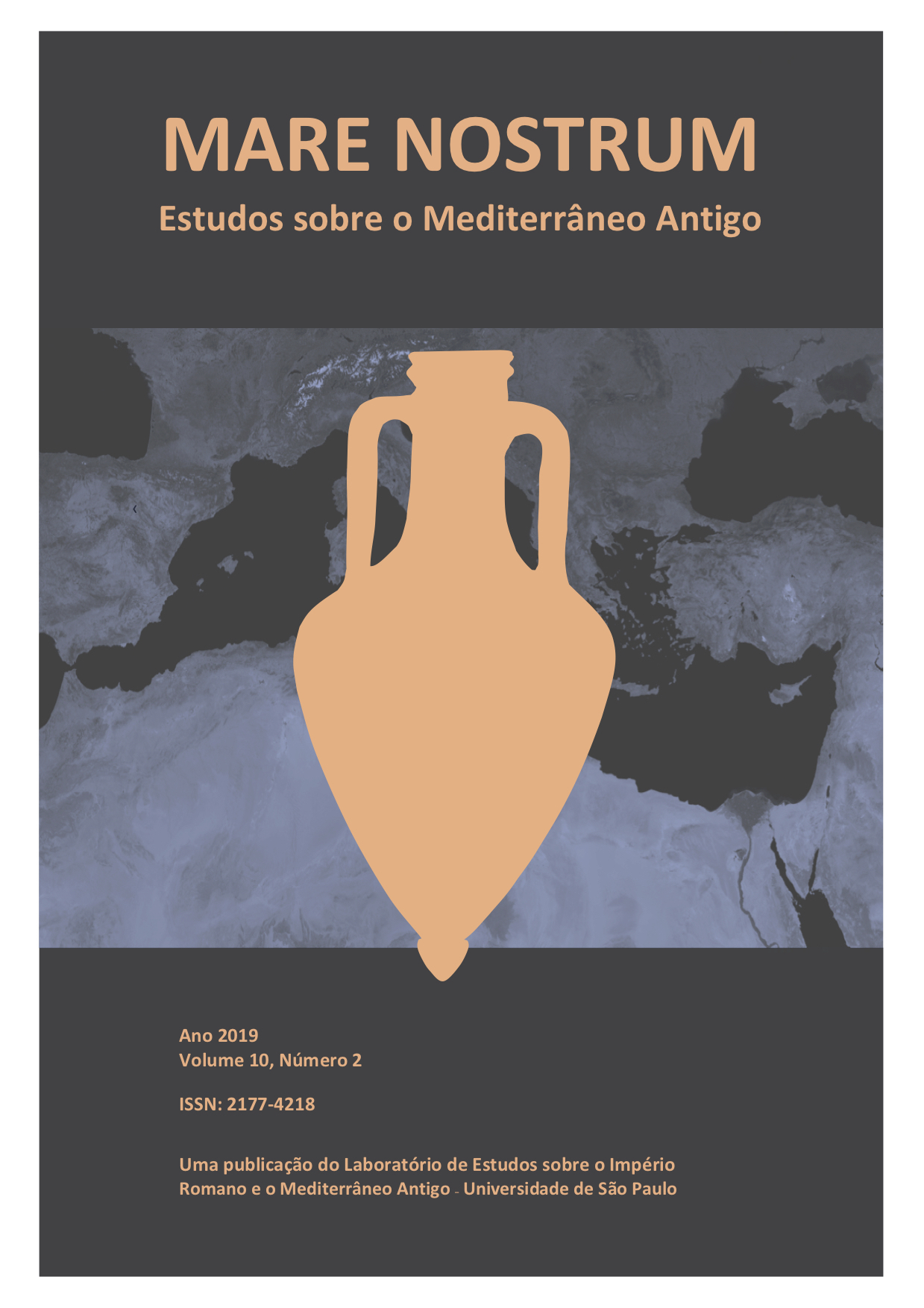Convulsões Sociais no Antigo Egito: os trabalhadores da necrópole Tebana no final do novo reinado
The Workers of Theban Necropolis in the end of the New Kingdom
DOI:
https://doi.org/10.11606/issn.2177-4218.v10i2p1-23Palavras-chave:
Antigo Egito, Novo Reinado, Período Raméssida, Deir el-Medina, TebasResumo
O período do Novo Reinado no Antigo Egito foi encerrado num contexto de convulsões sociais que minaram a autoridade faraônica, contribuindo para que o Alto e o Baixo Egito dividissem-se. Ao mesmo tempo em que se assiste à ascensão do peso dos templos na economia, em especial do Domínio de Amon, verifica-se o enfraquecimento do poder faraônico. Neste quadro, com uma crise econômica instalada, os trabalhadores da Necrópole Tebana começam a rebelar-se e, como forma de reivindicação, paralisam os trabalhos, naquela que ficou registrada como a primeira greve da História, sucedida por muitas outras. Após terem enfrentado ladrões de tumbas, ataques de bandos líbios e uma guerra civil, esses trabalhadores acabaram por deixar a vila de Deir el-Medina e integraram-se à indústria de pilhagem de tumbas reais, que se instalou em Tebas nos últimos anos da 20a Dinastia. Isto representou um novo fator de dinamismo para aquela economia.
Downloads
Referências
ANTOINE, Jean-Christophe. “The Delay of the Grain Ration and its Social Consequences at Deir el-Medîna in the Twentieth Dynasty: A Statistical Analysis”. In: The Journal of Egyptian Archaeology, volume 95. London: The Egyptian Exploration Society, 2009.
BARWIK, Miroslaw. The Twilight of Ramesside Egypt: studies on the History of the Ramesside Period. Warsaw: Agade, 2011.
BLEIBERG, Edward. The economy of ancient Egypt. In: SASSON, Jack (org.). Civilizations of the Ancient Near East, vol. 3. New York: Charles Scribner's Sons, 1995.
BREASTED, James. Ancient Records of Egypt, vol. 4. Chicago: The University Press, 1906.
CARDOSOS, Ciro. Considerações Funcionais acerca das Cidades Egípcias do Reino Novo (XVIIIa - XXa Dinastias). Revista Phoînix. Vol. 2, 1996, 71-82.
ČERNÝ, J. A community of workmen in Thebes in Ramessid Period. Cairo: Bibl. D’Étude, 1973.
CLINE, Eric & O’CONNOR, David. Ramesses III – The life and times of Egypt’s last hero. Michigan: The Univesity of Michigan Press, 2015.
COLE, Edward. Decline in Ancient Egypt? A reassessment of the Late New Kingdom and Third Intermediate Period. PhD Thesis. University of Birminghan, 2016.
COONEY, Kathlyn. “Profit or Exploitation? The Production of Private Ramesside Tombs within the West Theban Funerary Economy”. In: Journal of Egyptian History, 1, Brill: 2008, pp. 79-115.
DJIK, Jacobus. “The Amarna Period and the Later New Kingdom”. In: SHAWN, Ian (ORG.). The Oxford History of Ancient Egypt. New York: Oxford University Press, 2000.
DONNELY, Debborah. Archaeological and Geographical Evidence for the Voyage of Wenamun. MA: 2004.
EYRE, Christopher. Work and the organization of work in the New Kingdom. In: POWELL, M. (Ed.). Labor in the ancient Near East, Vol. 68. New Haven: American Oriental Society, 1987, pp. 167-221.
FRANK, André & GILLS, Barry. The World-System: five-hundred year or five thousands?. London & New York: Routhledge, 1996.
GARCIA, Juan Carlos. “Temples and agricultural labour in Egypt, from the Late New Kingdom to the Saite Period”. In: GARCIA, Juan Carlos (org.). Dynamics of Production in the Ancient Near East (1300–500 BC). Oxford: Oxbow, 2016.
GARDNER, Alan. Ramesside Administrative Documents. London: Oxford University Press, 1948.
GRANDET, Pierre. Ramses III: historie d’un règne. Paris: Pygmalion, 1993.
GRANDET, Pierre. “Les grèves de Deîr el-Médînéh”. In: Les régulations sociales dans l'Antiquité. Rennes: Presses universitaires de Rennes, 2006.
GRANDET, Pierre. "Early to Mid-20th Dynasty". In Grajetzki, Wolfram, Wendrich, Willeke (Org.). UCLA Encyclopedia of Egyptology. Los Angeles: University of California Press, 2014.
GRIMAL, Nicolas, A History of Ancient Egypt. London: Blackwell Books, 1993.
HARING, Ben. “Ramesside Temples and the Economic Interests of the State”. In: Das Heilige und die Ware Zum Spannungsfeld von Religion und Ökonomie, vol. 7, Berlin: IBAES, 2007.
HARING, Ben. Deir el-Medina. In: REDFORD, Donald (org.). The Oxford Encyclopedia of Ancient Egypt. Oxford: Oxford University Press, 2001.
HENRY, John. The Social Origins of Money: the case of Ancient Egypt. Disponível em: <http://www.csus.edu/indiv/h/henryjf/pdfs/egypt.pdf>. Sacramento: 2002.
JANSSEN, Jan. Commodity Prices from Ramessid Period. Leiden: E. J. Brill, 1975.
KATARY, Saly. Land and tenure in the Ramessid period. London and New York: Kegan Paul International, 1989.
KEMP, Barry. Ancient Egypt: Anatomy of a Civilization. 2 ed., Taylor & Francis Routledge, 2006.
LULL, José. “El Reino Nuevo II: la Época Ramésida”. In: ORTIZ, José (Org.). El Antiguo Egipto: Sociedad, Economía y Política. Madrid: Marcial Pons, 2008.
MANDEVILLE, Richard. Wage accounting in Deir Al-Medina. Wallasey: Abercromby Press, 2014.
MARX, Karl. Contribuição à Crítica da Economia Política. 2a Edição. São Paulo: Expressão Popular, 2008.
MCDOWELL, A. G. Village Life in Ancient Egypt: Laundry Lists and Love Songs. Oxford: Oxford University Press, 1999.
MESKELL, Lynn. “An Archaeology of Social Relations in an Egyptian Village”. Journal of Archaeological Method and Theory, Vol. 5, No. 3. Oxford: 1998.
MLADJOV, Ian. “The Transition between the Twentieth and Twenty-First Dynasties Revisited”. Birmingham Egyptology Journal, 5, 2017, pp. 1-23.
MORRIS, Ellen. The architecture of imperialism: military bases and the evolution of foreign policy in Egypt’s New Kingdom. Leiden & Boston: Brill, 2005.
PEDEN, Alexander. The Reign of Ramesses IV. Liverpool: Aris & Phillips Ltd, 1994.
PEDEN, Alexander. The Graffiti of Pharaonic Egypt. Leiden: Brill, 2001.
PEET, T. The Great Tomb Robberies of the 20th Egyptian Dynasty. New York: Hildesheim, 1997.
SHAWN, Ian. The Oxford History of Ancient Egypt. New York: Oxford University Press, 2000.
TOLEDO STELLA, Thomas. “Cosmogonias e Demiurgos: Diversidade Religiosa no Antigo Egito e sua Relação com o Poder Faraônico”. Anais III Encontro do GT História Antiga e Medieval ANPUH-SC. UFSC, 2018. Disponível: <https://gtantigamedievalsc.wixsite.com/iiiencontro>. Acesso: 14/3/2019.
TOLEDO STELLA, Thomas. “O Domínio de Amon : a importância de Ipetsut (Karnak) na economia egípcia do Reino Novo”. In: BRANCAGLION JR., Antônio & CHAPOT, Gisela (Org.), Semna: Estudos de Egiptologia, Volume 5, Rio de Janeiro: Editora Klíne, 2018.
VERNUS, Pascal. Affairs and Scandals in Ancient Egypt. Ithaca and London: Cornell University Press, 2003.
WARBURTON, David. “Before the IMF: the economic implications of unintentional structural adjustment in Ancient Egypt”. Journal of the Economic and Social History of the Orient. Vol. 43, No. 2, Leiden: Brill, 2000, pp. 65-131.
WARBURTON, David. “The Egyptian Example and the Macroeconomic Implications”. In: PERMA, Massimo (org.). Fiscality in Mycenean and Near Eastern Archieves. Paris: 2006.
WARBURTON, David. “What might the Bronze Age World-System Look-Like?”. In: WILKINSON, Toby, SHERRATT, Susan & BENNETT, John (Orgs.). Interweaving the World: Systemic Interactions in Eurasia, 7th to 1st Millennia BC. Oxford: Oxbow, 2011.
WATTS, Edith. Art of Ancient Egypt. New York: The Metropolitan Museum, 1998.
WILKINSON, Toby. The Rise and Fall of Ancient Egypt. London: Bloomsbery, 2010.
ZINGARELLI, Andrea. “Tebas durante el período Ramésida: redistribución y circulación de bienes”. Revista Mundo Antigo. Ano IV, V. 4, N° 07. Rio de Janeiro: 2015.
ZINGARELLI, Andrea. “Huelgas de trabajadores en el Imperio Nuevo egipcio”. In: ASTARITA, Carlos, McGAW, Carlos y ZINGARELLI, Andrea (Orgs.). Confictos sociales en la Antigüedad y el Feudalismo. La Plata: Editorial de la Universidad de La Plata. 2017A.
ZINGARELLI, Andrea. “Contradicciones sociales a fines del Imperio Nuevo egipcio: los robos de bienes”. In: ASTARITA, Carlos, McGAW, Carlos y ZINGARELLI, Andrea (Orgs.). Confictos sociales en la Antigüedad y el Feudalismo. La Plata: Editorial de la Universidad de La Plata. 2017B.
Downloads
Publicado
Edição
Seção
Licença
Copyright (c) 2019 Thomas Henrique de Toledo Stella

Este trabalho está licenciado sob uma licença Creative Commons Attribution 4.0 International License.
Os conteúdos expressos nos textos publicados pela Mare Nostrum são de exclusiva responsabilidade de seus respectivos autores.
A reprodução dos textos editados pela Mare Nostrum é permitida sob licença Creative Commons, Atribuição-NãoComercial (CC BY-NC).
Autores que publicam nesta revista concordam com os seguintes termos:
- Autores mantém os direitos autorais e concedem à revista o direito de primeira publicação, com o trabalho simultaneamente licenciado sob a Licença Creative Commons Attribution que permite o compartilhamento do trabalho com reconhecimento da autoria e publicação inicial nesta revista.
- Autores têm autorização para assumir contratos adicionais separadamente, para distribuição não-exclusiva da versão do trabalho publicada nesta revista (ex.: publicar em repositório institucional ou como capítulo de livro), com reconhecimento de autoria e publicação inicial nesta revista.
- Autores têm permissão e são estimulados a publicar e distribuir seu trabalho online (ex.: em repositórios institucionais ou na sua página pessoal) a qualquer ponto antes ou durante o processo editorial, já que isso pode gerar alterações produtivas, bem como aumentar o impacto e a citação do trabalho publicado (Veja O Efeito do Acesso Livre).









